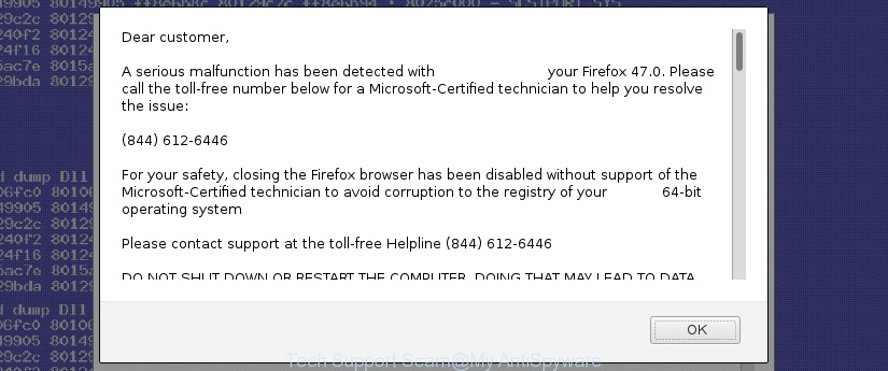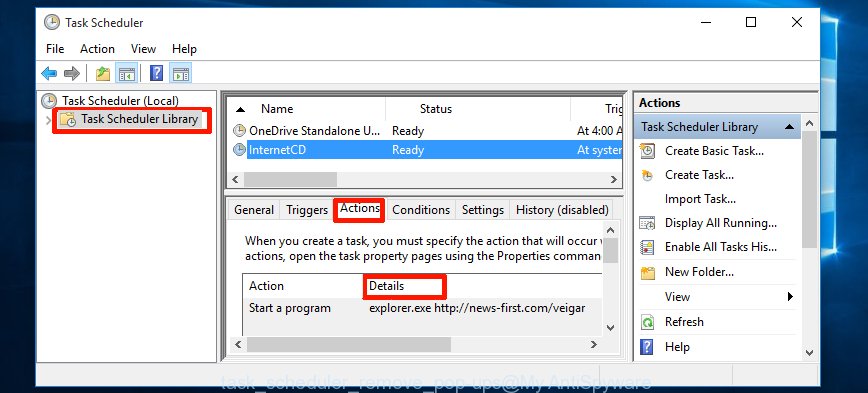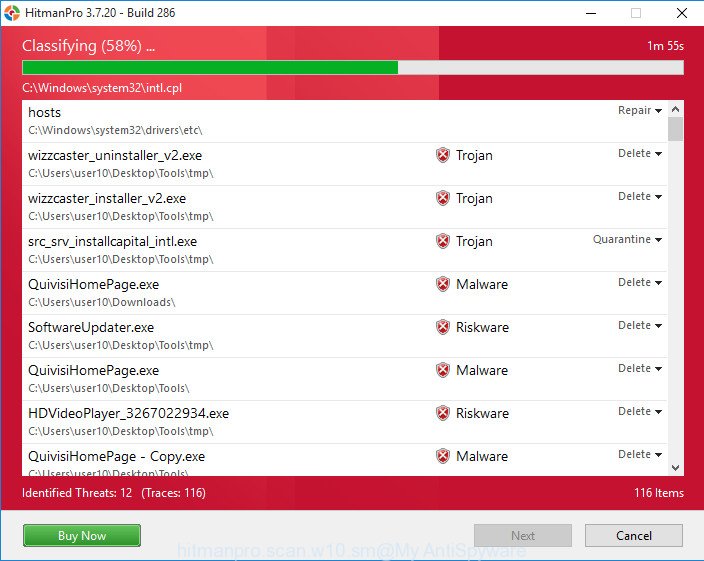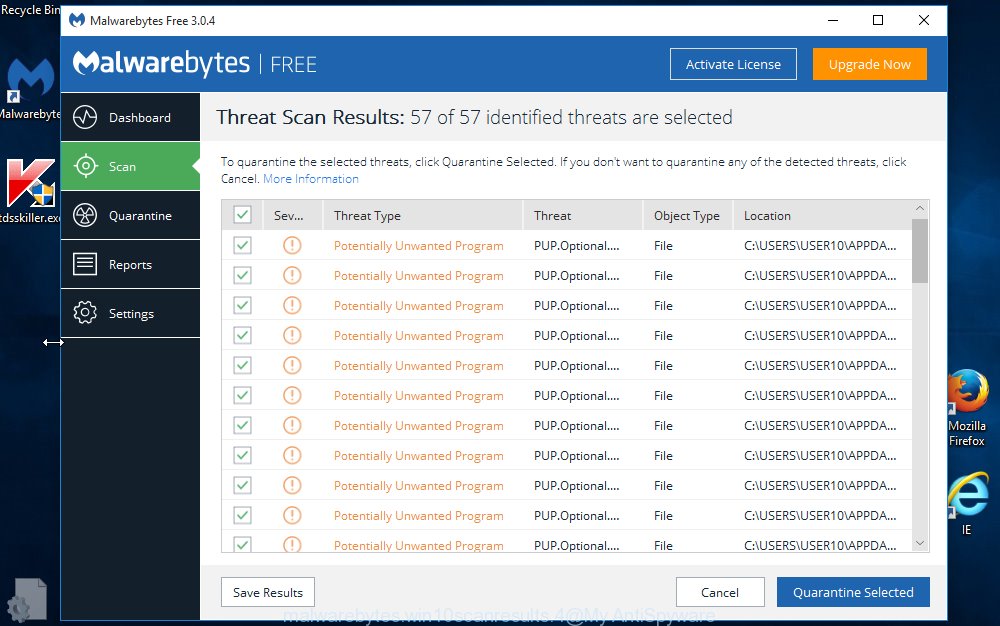What is “Tech Support Scam”? The Tech Support Scam is a misleading advertising that created in order to trick you into calling a fake Microsoft (Apple) Tech Support. Are you seeing Tech Support Scam pop ups in the Chrome, Firefox, Internet Explorer and Edge every time you use the web-browser to browse the Net? It’s a sign that you’re a victim of unwanted software from Adware (sometimes called ‘ad-supported’ software) family. Adware is a potentially unwanted application (PUA) that designed to display unwanted commercials, deals, offers, pop-ups and ads on the affected system. In this article we will discuss what ad-supported software is and how can you remove Tech Support Scam pop-up virus from the Google Chrome, MS Edge, Internet Explorer, Mozilla Firefox and Safari manually or with free adware removal utilities compatible with MS Windows and Apple Mac OS.

As well as unwanted web browser redirects to Tech Support Scam, Adware may collect your Net browsing activity by recording URLs visited, IP addresses, web browser version and type, cookie information, Internet Service Provider (ISP) and webpages visited. Such kind of behavior can lead to serious security problems or confidential data theft. This is another reason why adware that causes misleading Tech Support Scam pop up warnings on your internet browser, is classified as potentially unwanted application (PUA).
In addition to that, as was mentioned earlier, some adware to also alter all web browsers shortcut files that located on your Desktop or Start menu. So, every affected shortcut will try to redirect your web browser to unwanted ad sites like Tech Support Scam, certain of which might be malicious. It can make the whole PC system more vulnerable to hacker attacks.
Thus, the adware is quite dangerous. So, we recommend you get rid of it from your computer immediately. Follow the steps presented below to remove Tech Support Scam pop-up virus from the Mozilla Firefox, MS Edge, IE and Google Chrome.
How to remove Tech Support Scam pop-up virus
We can help you remove Tech Support Scam from your browsers, without the need to take your PC to a professional. Simply follow the removal tutorial below if you currently have the unwanted ‘ad supported’ software on your PC and want to delete it. If you have any difficulty while trying to get rid of the adware that shows misleading Tech Support Scam popup on your computer, feel free to ask for our help in the comment section below. Read this manual carefully, bookmark or print it, because you may need to shut down your web-browser or reboot your personal computer.
To remove Tech Support Scam popup, execute the steps below:
- Delete suspicious software through the Control Panel of your computer
- Remove Tech Support popup scam from Google Chrome
- Delete Tech Support Scam from Internet Explorer
- Get rid of Tech Support Scam pop-up from Mozilla Firefox by resetting browser settings
- Remove Tech Support Scam popup with free tools
- How to stop Tech Support Scam pop-ups
How to remove Tech Support Scam pop up warnings without any software
Most common adware may be removed without any antivirus apps. The manual ‘ad supported’ software removal is guidance that will teach you how to get rid of the Tech Support Scam popup warnings.
Delete suspicious software through the Control Panel of your computer
The process of adware removal is generally the same across all versions of Windows OS from 10 to XP. To start with, it’s necessary to check the list of installed apps on your computer and uninstall all unused, unknown and questionable programs.
Windows 8, 8.1, 10
First, click Windows button

After the ‘Control Panel’ opens, click the ‘Uninstall a program’ link under Programs category as on the image below.

You will see the ‘Uninstall a program’ panel like below.

Very carefully look around the entire list of programs installed on your computer. Most likely, one of them is the adware that causes multiple misleading Tech Support Scam alerts and pop-ups. If you have many applications installed, you can help simplify the search of malicious apps by sort the list by date of installation. Once you have found a questionable, unwanted or unused application, right click to it, after that click ‘Uninstall’.
Windows XP, Vista, 7
First, press ‘Start’ button and select ‘Control Panel’ at right panel as displayed in the figure below.

Once the Windows ‘Control Panel’ opens, you need to press ‘Uninstall a program’ under ‘Programs’ as shown on the image below.

You will see a list of programs installed on your system. We recommend to sort the list by date of installation to quickly find the programs that were installed last. Most likely, it’s the adware that cause misleading Tech Support Scam pop up scam to appear. If you are in doubt, you can always check the program by doing a search for her name in Google, Yahoo or Bing. When the program which you need to uninstall is found, simply click on its name, and then press ‘Uninstall’ as displayed in the following example.

Remove Tech Support popup scam from Google Chrome
Reset Google Chrome settings is a easy way to get rid of the browser hijackers, harmful and ‘ad-supported’ extensions, as well as to restore the browser’s default search provider, newtab page and startpage that have been modified by ad supported software that causes web browsers to display misleading Tech Support Scam.
First start the Google Chrome. Next, press the button in the form of three horizontal dots (![]() ).
).
It will show the Google Chrome menu. Select More Tools, then click Extensions. Carefully browse through the list of installed plugins. If the list has the extension signed with “Installed by enterprise policy” or “Installed by your administrator”, then complete the following steps: Remove Google Chrome extensions installed by enterprise policy.
Open the Chrome menu once again. Further, press the option named “Settings”.

The internet browser will show the settings screen. Another solution to show the Google Chrome’s settings – type chrome://settings in the internet browser adress bar and press Enter
Scroll down to the bottom of the page and press the “Advanced” link. Now scroll down until the “Reset” section is visible, as displayed in the following example and press the “Reset settings to their original defaults” button.

The Google Chrome will open the confirmation dialog box as displayed on the image below.

You need to confirm your action, click the “Reset” button. The web browser will start the procedure of cleaning. After it’s finished, the web browser’s settings including new tab, homepage and search provider by default back to the values that have been when the Google Chrome was first installed on your PC.
Delete Tech Support Scam from Internet Explorer
By resetting Microsoft Internet Explorer browser you restore your internet browser settings to its default state. This is good initial when troubleshooting problems that might have been caused by ‘ad supported’ software that displays misleading Tech Support Scam pop up warnings on your machine.
First, start the Internet Explorer. Next, press the button in the form of gear (![]() ). It will open the Tools drop-down menu, press the “Internet Options” like below.
). It will open the Tools drop-down menu, press the “Internet Options” like below.

In the “Internet Options” window click on the Advanced tab, then press the Reset button. The Internet Explorer will open the “Reset Internet Explorer settings” window as on the image below. Select the “Delete personal settings” check box, then press “Reset” button.

You will now need to restart your PC system for the changes to take effect.
Get rid of Tech Support Scam from Mozilla Firefox by resetting browser settings
If your Mozilla Firefox web-browser is rerouted to Tech Support Scam without your permission or an unknown search provider opens results for your search, then it may be time to perform the internet browser reset. It’ll keep your personal information such as browsing history, bookmarks, passwords and web form auto-fill data.
First, run the Firefox. Next, click the button in the form of three horizontal stripes (![]() ). It will open the drop-down menu. Next, press the Help button (
). It will open the drop-down menu. Next, press the Help button (![]() ).
).

In the Help menu click the “Troubleshooting Information”. In the upper-right corner of the “Troubleshooting Information” page press on “Refresh Firefox” button as shown below.

Confirm your action, press the “Refresh Firefox”.
Remove unwanted Scheduled Tasks
If Tech Support Scam opens automatically on Windows startup or at equal time intervals, then you need to check the Task Scheduler Library and get rid of all tasks which have been created by ‘ad-supported’ apps.
Press Windows and R keys on your keyboard simultaneously. It will display a dialog box that called Run. In the text field, type “taskschd.msc” (without the quotes) and press OK. Task Scheduler window opens. In the left-hand side, click “Task Scheduler Library”, as shown on the image below.

Task scheduler, list of tasks
In the middle part you will see a list of installed tasks. Select the first task, its properties will be display just below automatically. Next, click the Actions tab. Necessary to look at the text which is written under Details. Found something such as “explorer.exe http://site.address” or “chrome.exe http://site.address” or “firefox.exe http://site.address”, then you need get rid of this task. If you are not sure that executes the task, then google it. If it is a component of the adware, then this task also should be removed.
Further click on it with the right mouse button and select Delete like below.

Task scheduler, delete a task
Repeat this step, if you have found a few tasks that have been created by unwanted apps. Once is done, close the Task Scheduler window.
Disinfect the browser’s shortcuts to remove Tech Support Scam
When installed, this adware that causes web-browsers to open misleading Tech Support Scam pop up scam, may add an argument such as “http://site.address” into the Target property of the desktop shortcut file for the Chrome, Mozilla Firefox, Edge and IE. Due to this, every time you start the web browser, it’ll open an annoying ad web site.
To clear the web-browser shortcut file, right-click to it and select Properties. On the Shortcut tab, locate the Target field. Click inside, you will see a vertical line – arrow pointer, move it (using -> arrow key on your keyboard) to the right as possible. You will see a text similar to “http://site.address” which has been added here. You need to delete it.

When the text is removed, press the OK button. You need to clean all shortcuts of all your internet browsers, as they may be hijacked too.
Remove Tech Support Scam popup with free tools
Manual removal guide does not always help to completely remove the adware, as it’s not easy to identify and get rid of components of adware and all malicious files from hard disk. Therefore, it is recommended that you run malicious software removal tool to completely get rid of Tech Support Scam off your internet browser. Several free malicious software removal tools are currently available that may be used against the ad supported software. The optimum way would be to run Zemana AntiMalware, MalwareBytes Anti Malware and Hitman Pro.
Use Zemana Anti-malware to delete Tech Support Scam
We advise using the Zemana Anti-malware. You may download and install Zemana Anti-malware to detect and remove Tech Support Scam popup from the Internet Explorer, Firefox, Edge and Google Chrome browsers. When installed and updated, the malicious software remover will automatically scan and detect all threats present on your PC system.
Now you can set up and use Zemana to remove Tech Support Scam from your web browser by following the steps below:
Visit the page linked below to download Zemana Anti-Malware install package named Zemana.AntiMalware.Setup on your machine. Save it to your Desktop.
165044 downloads
Author: Zemana Ltd
Category: Security tools
Update: July 16, 2019
Launch the setup file after it has been downloaded successfully and then follow the prompts to install this tool on your PC system.

During installation you can change certain settings, but we suggest you do not make any changes to default settings.
When setup is done, this malicious software removal utility will automatically start and update itself. You will see its main window like below.

Now click the “Scan” button to begin scanning your computer for the ad supported software that causes multiple misleading Tech Support Scam alerts and pop-ups. A scan can take anywhere from 10 to 30 minutes, depending on the number of files on your computer and the speed of your PC system. During the scan Zemana Free will detect threats present on your computer.

After the scan is finished, the results are displayed in the scan report. In order to delete all threats, simply press “Next” button.

The Zemana Anti-Malware will start to uninstall adware and other malicious software. After the procedure is done, you can be prompted to restart your PC system to make the change take effect.
Use HitmanPro to delete Tech Support Scam from browser
HitmanPro is a completely free (30 day trial) utility. You do not need expensive methods to remove adware and other malicious apps. HitmanPro will remove all the undesired apps like adware and hijackers for free.

- Installing the HitmanPro is simple. First you’ll need to download HitmanPro by clicking on the link below.
- When the downloading process is finished, double click the HitmanPro icon. Once this tool is opened, click “Next” button to perform a system scan with this utility for the ‘ad supported’ software that causes misleading Tech Support Scam pop-ups on your web-browser. Depending on your PC system, the scan can take anywhere from a few minutes to close to an hour. When a malware, adware or PUPs are found, the number of the security threats will change accordingly. Wait until the the scanning is complete.
- When that process is done, Hitman Pro will show a list of found items. Next, you need to click “Next” button. Now press the “Activate free license” button to begin the free 30 days trial to delete all malicious software found.
How to automatically get rid of Tech Support Scam with Malwarebytes
We recommend using the Malwarebytes Free. You can download and install Malwarebytes to scan for ad supported software and thereby get rid of Tech Support Scam pop up warnings from your web-browsers. When installed and updated, the free malicious software remover will automatically check and detect all threats exist on the system.

- Visit the following page to download the latest version of MalwareBytes Anti Malware for Microsoft Windows. Save it directly to your Windows Desktop.
Malwarebytes Anti-malware
327273 downloads
Author: Malwarebytes
Category: Security tools
Update: April 15, 2020
- At the download page, click on the Download button. Your web browser will show the “Save as” prompt. Please save it onto your Windows desktop.
- When the download is finished, please close all programs and open windows on your computer. Double-click on the icon that’s called mb3-setup.
- This will open the “Setup wizard” of MalwareBytes Free onto your machine. Follow the prompts and don’t make any changes to default settings.
- When the Setup wizard has finished installing, the MalwareBytes Free will run and show the main window.
- Further, click the “Scan Now” button to begin checking your system for the adware which cause misleading Tech Support Scam popup scam to appear. This process can take some time, so please be patient. While the utility is checking, you may see how many objects and files has already scanned.
- After the checking is complete, you’ll be opened the list of all found threats on your PC.
- Once you have selected what you wish to remove from your PC system press the “Quarantine Selected” button. When the task is finished, you may be prompted to restart the PC.
- Close the Anti-Malware and continue with the next step.
Video instruction, which reveals in detail the steps above.
How to stop Tech Support Scam pop-ups
The AdGuard is a very good ad-blocking application for the Chrome, Microsoft Internet Explorer, Mozilla Firefox and Microsoft Edge, with active user support. It does a great job by removing certain types of unwanted advertisements, popunders, pop-ups, unwanted new tabs, and even full page ads and webpage overlay layers. Of course, the AdGuard can stop the Tech Support Scam pop-ups automatically or by using a custom filter rule.
Click the link below to download the latest version of AdGuard for MS Windows. Save it directly to your MS Windows Desktop.
26902 downloads
Version: 6.4
Author: © Adguard
Category: Security tools
Update: November 15, 2018
Once the downloading process is complete, double-click the downloaded file to run it. The “Setup Wizard” window will show up on the computer screen as displayed in the following example.

Follow the prompts. AdGuard will then be installed and an icon will be placed on your desktop. A window will show up asking you to confirm that you want to see a quick guide as shown below.

Click “Skip” button to close the window and use the default settings, or press “Get Started” to see an quick tutorial which will help you get to know AdGuard better.
Each time, when you launch your PC system, AdGuard will start automatically and block unwanted advertisements, Tech Support Scam pop-ups, as well as other harmful or misleading web pages. For an overview of all the features of the program, or to change its settings you can simply double-click on the AdGuard icon, which may be found on your desktop.
How did Tech Support Scam pop up scam get on your computer
These days certain free programs authors bundle optional applications which could be PUPs like this ad supported software, with a view to making some money. These are not free programs as install an unwanted apps on to your MS Windows PC system. So whenever you install a new free program that downloaded from the Web, be very careful during installation. Carefully read the EULA (a text with I ACCEPT/I DECLINE button), select custom or manual installation mode, disable all third-party programs.
Finish words
Once you’ve finished the guidance outlined above, your system should be clean from this ad-supported software and other malware. The IE, Chrome, Mozilla Firefox and MS Edge will no longer open Tech Support Scam pop-ups when you browse the World Wide Web. Unfortunately, if the step-by-step guide does not help you, then you have caught a new adware, and then the best way – ask for help.
Please start a new thread by using the “New Topic” button in the Spyware Removal forum. When posting your HJT log, try to give us some details about your problems, so we can try to help you more accurately. Wait for one of our trained “Security Team” or Site Administrator to provide you with knowledgeable assistance tailored to your problem with Tech Support Scam pop up virus.




















